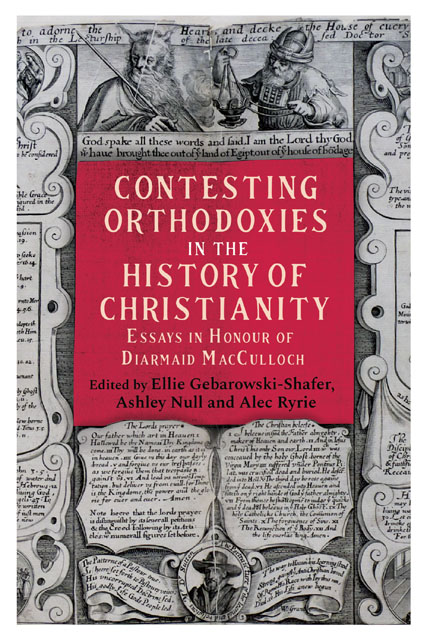Book contents
- Frontmatter
- Contents
- List of Illustrations
- List of Contributors
- List of Abbreviations
- Introduction
- 1 ‘Jewish Christianity’ in Antiquity: Meaningless Category or Heuristic Irritant?
- 2 ‘Sola Fide’: the Wrong Slogan?
- 3 Both Cromwellian and Augustinian: the Influence of Thomas Cromwell on Reform within the Early Modern English Austin Friars
- 4 Lex, Rex and Sex: The Bigamy of Philipp of Hesse and the Lutheran Recourse to Natural Law
- 5 The Authority of Scripture in Reformation Anglicanism: Then and Now
- 6 Orthodoxy and Heresy in the Post-Reformation
- 7 Profanity and Piety in the Church Porch: the Place of Transgression in Early Modern England
- 8 Writing on the Walls: Word and Image in the Post-Reformation English Church
- 9 The Myth of the Church of England
- 10 Mysticism, Orthodoxy and Reformed Identity before the English Revolution: the Case of John Everard
- 11 Sacrilege and the Sacred in England’s Second Reformation, 1640–1660
- 12 ‘I had not the patience to be quiet’: Arthur Bury and The Naked Gospel
- 13 ‘A soul-corrupting indifferentism’: the Intellectual Development of Benjamin Henry Latrobe
- 14 Newman, Dogma and Freedom in the Church
- 15 ‘Tommy, ’ow’s yer soul?’ Reconsidering Religion and the British Soldier
- 16 The King James Vulgate
- 17 The Myth of the Anglican Communion?
- Select bibliography of Diarmaid MacCulloch’s scholarly publications
- Bibliography
- Index
- Tabula Gratulatoria
- Studies in Modern British Religious History
11 - Sacrilege and the Sacred in England’s Second Reformation, 1640–1660
Published online by Cambridge University Press: 09 January 2024
- Frontmatter
- Contents
- List of Illustrations
- List of Contributors
- List of Abbreviations
- Introduction
- 1 ‘Jewish Christianity’ in Antiquity: Meaningless Category or Heuristic Irritant?
- 2 ‘Sola Fide’: the Wrong Slogan?
- 3 Both Cromwellian and Augustinian: the Influence of Thomas Cromwell on Reform within the Early Modern English Austin Friars
- 4 Lex, Rex and Sex: The Bigamy of Philipp of Hesse and the Lutheran Recourse to Natural Law
- 5 The Authority of Scripture in Reformation Anglicanism: Then and Now
- 6 Orthodoxy and Heresy in the Post-Reformation
- 7 Profanity and Piety in the Church Porch: the Place of Transgression in Early Modern England
- 8 Writing on the Walls: Word and Image in the Post-Reformation English Church
- 9 The Myth of the Church of England
- 10 Mysticism, Orthodoxy and Reformed Identity before the English Revolution: the Case of John Everard
- 11 Sacrilege and the Sacred in England’s Second Reformation, 1640–1660
- 12 ‘I had not the patience to be quiet’: Arthur Bury and The Naked Gospel
- 13 ‘A soul-corrupting indifferentism’: the Intellectual Development of Benjamin Henry Latrobe
- 14 Newman, Dogma and Freedom in the Church
- 15 ‘Tommy, ’ow’s yer soul?’ Reconsidering Religion and the British Soldier
- 16 The King James Vulgate
- 17 The Myth of the Anglican Communion?
- Select bibliography of Diarmaid MacCulloch’s scholarly publications
- Bibliography
- Index
- Tabula Gratulatoria
- Studies in Modern British Religious History
Summary
Orthodoxy is a shifting target, and so is the terminology used to manage it. This essay explores the plight of royalist defenders of the former Protestant establishment in seventeenth-century England – those who would later be called Anglicans – as they lamented the destruction, impropriation and secularisation of church property during the Civil War and Republic. These people could be forgiven for being perplexed: they embraced doctrines which in the previous century would have risked sending them to the fire as heretics, but which in their own times saw them damned as crypto-papists. They believed themselves to have stayed in the same position; as a result, they had changed sides. This was not merely about shifts in definitions, but also in language. The essay explores how, during the 1640s and 1650s, the term ‘sacrilege’ went from being a Catholic response to Protestant iconoclasm and plunder to a widespread English Protestant response to the parliamentary and republican regimes’ seizures and depredations of church property, material, spiritual and theological. The experience served to nurture the growth of an emergent new orthodoxy: the High Church sensibility that would become a part of nascent Anglicanism.
The problem of ‘sacrilege’ in England’s two Reformations
One view of the impact of the Reformation in England, still held widely in academia and more broadly, is that a vibrant, lively form of Christianity – Catholicism – was replaced by a dry and colourless one – Protestantism. Eamon Duffy and J. J. Scarisbrick have in particular been highly influential in this regard. Both scholars have described with heartbreaking detail the attack on what one might call the ‘property’ of the medieval church – both its material and spiritual property – and the resulting spiritual void for English worshippers. To quote Scarisbrick:
The Reformation simplified everything. It effected a shift from a religion of symbol and allegory, ceremony and formal gesture to one that was plain and direct: a shift from the visual to the aural, from ritual to literal exposition, from the numinous and mysterious to the everyday. It moved from … a religion that sought out all the senses, to one that concentrated on the word and innerliness.
- Type
- Chapter
- Information
- Contesting Orthodoxies in the History of ChristianityEssays in Honour of Diarmaid MacCulloch, pp. 193 - 207Publisher: Boydell & BrewerPrint publication year: 2021



